Astrophysics Theory Notes
Stellar quantities
The sun:
The sun rises in the east and goes down in the west. This is due to rotation of earth about its own axis. The revolution of earth around the sun is the reason for seasons. The earth’s rotation axis is not aligned with the axis of revolution. So, the sun appears to move in a different path every day. The electromagnetic radiation from the sun is due to nuclear fusion taking place in the core. The energy released in these reactions heat up the surface and energy is radiated.
The moon:
Due to the rotation of earth, the moon also appears to be moving from west to east. The moon appears to rise slightly later every night. This is due to the revolution of the moon around earth. This revolution has a period of 27.3 days. The moon does not produce any light on its own but reflects the light from the sun.
Stars:
Stars are spherical sources of light just like the sun. The closest star other than the sun is Alpha Centauri which is at a distance of 4 light years. One light year is the distance travelled by light in a year. Deneb, one of the most distant stars, is an easily visible star at a distance of 3200 light years. The motion of earth causes the stars to be visible at a different place with time. Also, the stars are in motion. But this motion is very minute as seen from the earth. Some stars are joined by imaginary lines by our ancestors and these are called constellations. They are useful to identify objects in space. The stars in these constellations are actually light years apart. The stars that are close together are called stellar clusters.
Each star is unique in terms of its brightness and colour. The twinkling of stars is due to atmosphere. The light from stars can give us a lot of information about the stars.
Planet:
A planet is a celestial object that is in orbit around the sun, has sufficient mass to overcome rigid body forces to become nearly spherical and has cleared neighbourhood around its orbit. Some of the bright objects in the night sky are actually planets that orbit the sun just like earth.
There are 40 dwarf planets that also orbit the sun of which Pluto is one. Asteroids and comets also orbit the sun. Asteroids are lumps of rocks of diameter around 1000km that orbit the sun in the asteroid belt between Mars and Jupiter. They are not visible most of the time with naked eye. Comets are lumps of rock, ice and frozen gases and spend most of their time in outer parts of the solar system.
Galaxy:
Galaxies appear like stars in the night sky. Galaxies are groups of around 1011 stars across 105 lightyears. Our solar system is itself a part of the milky way galaxy whose stars are what we see during night. Galaxies are grouped in galaxy clusters, ours being clustered in a group of 20 galaxies. Group of clusters is called a supercluster.
Astronomical distances:
Stellar distances – distances between celestial objects is so large. So, convenient units are used while talking about stellar objects.
Light year: The distance travelled by light in vacuum in one year.
1𝑙𝑦 = 9.46 × 1015𝑚
Astronomical unit: Average distance between earth and sun.
1𝐴.𝑈 = 1.5 × 1011m
Parsec(pc): If the angle subtended between two points separated by a distance 1A.U and a distant star is one arcsec, the distance to the star is 1 parsec.
1𝑝𝑐 = 3.26𝑙𝑦
Stellar parallax:
Parallax is the change in angle when an object is viewed from two different places.
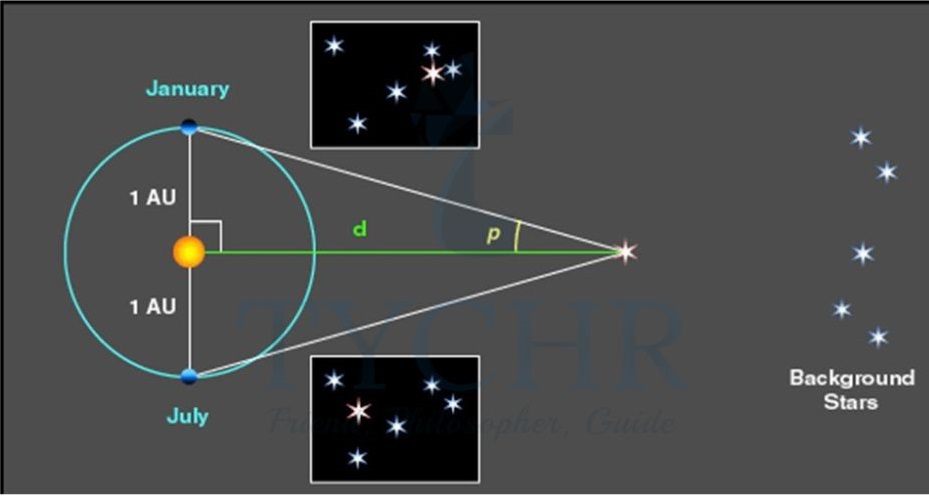
The distance to the red star given by:
𝑑(𝑝𝑎𝑟𝑠𝑒𝑐) = 1/ 𝑝(𝑎𝑟𝑐𝑠𝑒𝑐)
Radiation from stars:
Apparent brightness (b) is the brightness of the star as perceived on earth.
Luminosity (L) of a star is the total energy emitted by the star per unit time.
Apparent brightness at a distance d and luminosity are related as:
𝑏 = 𝐿 / 4𝜋𝑟2
Stellar spectra:
Stars are perfect radiators.
The power radiated by a star of surface area A whose surface is at a temperature T is
𝑃 = 𝜎𝐴𝑇4
The peak wavelength of the radiation emitted by the star is given by Wein’s displacement law
𝜆 = 2.9 × 10−3/T
Absorption spectra:
The dark lines in the spectra of a star can be used to determine the gases present in the outer layer of a star. This can also be used to determine the temperature of a star by comparing the absorption frequency with excitation energy for various gases. The stars are classified based on their colour. The Harvard classification is given below.

Luminosity classification:
The dark lines in absorption spectrum of a star are fine but have a finite width due to Doppler broadening and Pressure broadening.
Doppler broadening is due to the motion of atoms. When an atom is in motion, the frequency of photon emitted changes from its original value due to doppler effect. Stars with same temperature will have same amount of Doppler broadening.
Pressure broadening is due to the pressure of the gas. Gases under higher pressure have higher broadening than those at lower pressure. Large stars have lower pressures than small stars at the surface.
So, the width of spectral lines is directly related to size of star and hence its luminosity. This leads to the Yerkes classification of stars.

Hertzsprung-Russel diagrams:
A Hertzsprung-Russel diagram is a graph on which temperature of a star is plotted against its luminosity. The Y-axis is luminosity in logarithmic scale and X-axis is the temperature greatest at the left end. The temperature is not linear on X-axis. The size of a star can be easily deduced from its position on the graph. The diagonal lines represent stars of equal radius.
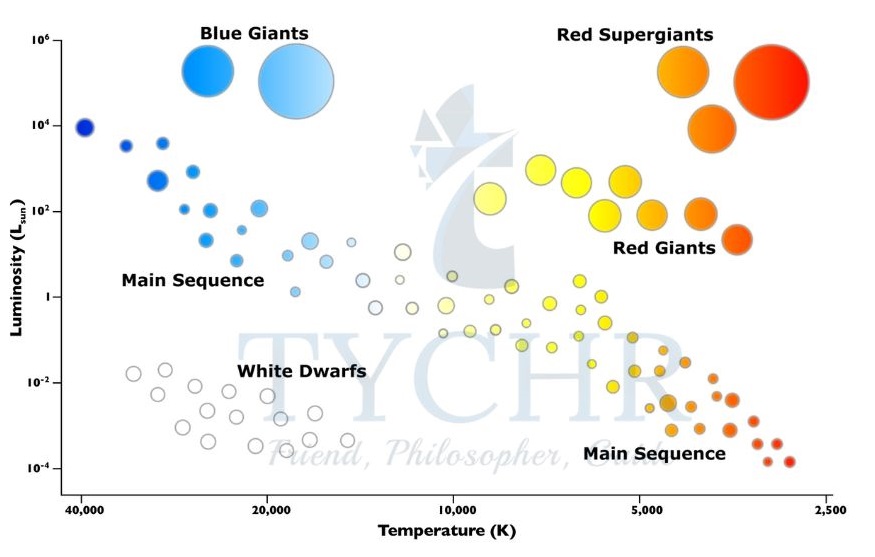
Main sequence: 90% stars including the fall on the diagonal band called main sequence. The core of such stars undergoes fusion from hydrogen to helium releasing energy. This released energy creates pressure and keeps the star from collapsing. These are stable and remain at the same point of the graph for a long time.
Red giants: These stars are large and are of less temperature.
Super giants: These are very large and cold. Luminosity is up to 106 times greater than sun and radius about 1000 times that of sun.
White dwarfs: These are hot and small. They are hard to see without a telescope.
Cepheid Variables: These stars have variable luminosity. The luminosity is generally periodic in such stars.
Determining distance with HR diagrams:
The temperature can be found from absorption lines and luminosity from their width. Using these two, the star can be placed on the HR diagram. With luminosity found, the distance to the star can be calculated.
Mass-Luminosity relationship:
Binary stars mass can be found by determining their time period. For stars of main sequence, the relationship between luminosity and mass is
𝐿 𝛼 𝑚3.5
As the mass and luminosity of sun is known, mass of an unknown star can be found by its luminosity.
Cepheid variables:
The luminosity and period of Cepheid variables form a relationship as shown.
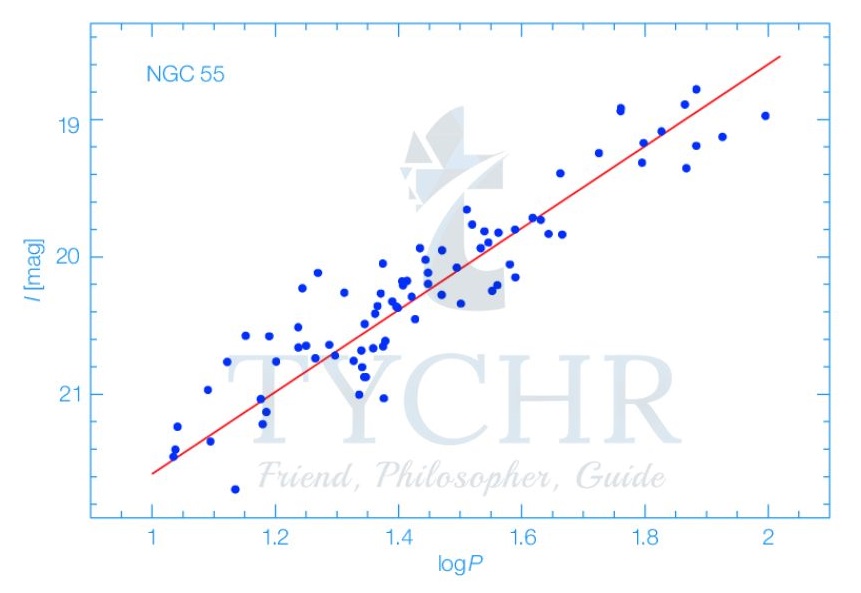
So, if the period of a cepheid variable is known, then its luminosity can be estimated. With the apparent brightness measured, the distance can be calculated.
Stellar evolution
Birth of a star:
The evolution of a star can be deduced by observing different stars and their numbers. Stars start as giant molecular clouds. These clouds consist of swirling dust and gases especially hydrogen. The temperature of these clouds is only about 10K. The clouds are held together by gravity but the pressure of gases keeps the clouds from collapsing. The shockwave from a nearby exploding star or collision between two clouds overcomes the pressure of gases and the cloud begins to collapse. The minimum mass required for a given mass to collide is given by Jeans criterion.
𝑀𝐽 = 3𝑘𝑇𝑅/2𝑔m
The cloud then collapses under gravitational forces forming many stars. The cloud eventually collapses to form many stars of different sizes and all the dust is used up. The core of such star (protostar) becomes so dense and hot that hydrogen undergoes nuclear fusion to become helium. The corresponding equation is summarised as:
411𝐻 → 24𝐻𝑒 + 2𝑒+ + 2𝜈𝑒 + 2𝛾
Once the fusion starts to happen, the energy released from the fusion keeps the star from collapsing. The protostar is then a stable main sequence star. The protostar is at the same position as that of a red giant in a HR diagram but has very different properties.
Main sequence:
The star then remains as a main sequence star until most of the hydrogen is used up. The lifetime (Δ𝑡) of a star is related to its mass as:
Δ𝑡 𝛼 𝑀−2.5
The star mass can be compared with the mass of sun to get its lifetime in terms of life of sun.
After the main sequence:
The star will remain as a main sequence until the hydrogen is used up. The helium formed, being denser sinks to the core. Hydrogen fusion continues in the outer core until the temperature and pressure are no longer sufficient to sustain fusion. The pressure due to the fusion decreases and the star starts to collapse causing the temperature of core to increase. The temperature of gases in the outer layers also increases causing them to expand. The star then transforms in to a red giant.
What happens next depends on the mass of star.
Sun sized stars:
The core continues to get smaller until electron degeneracy prevents it. The core then cannot become smaller but continues to become hotter. When the core temperature exceeds 108K, helium fuses in a series of reactions called triple alpha process to form oxygen.
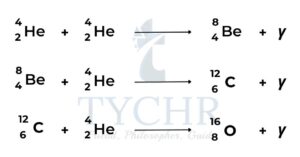
The outer layers are not well held by gravitational forces and are blown away eventually. The star is now a white dwarf. White dwarfs get smaller as they get heavier. Electron degeneracy sets a limit on the mass of a star’s core that can form a white dwarf.
Chandrasekhar limit = 1.4𝑀0
Mo is the mass of sun. The total mass of a star is about thrice the mass of its core. Stars with mass greater than 4Mo do not form white dwarfs.
If the white dwarf is a part of binary system, it attracts mass from partner star and mass increases. When the mass exceeds Chandrasekhar limit, the white dwarf violently collapses causing a type 1a supernova which results in a peak luminosity of 1010Lo. Lo is the luminosity of sun.
Large stars:
For the stars with mass greater than 4Mo, the pressure is sufficient for further fusion. The fusion happens until iron is produced. When the core runs out of nuclear fuel, it collapses. The mass is greater than Chandrasekhar limit. So, the contraction is not limited by electron degeneracy. The electrons and protons collapse to release energy until only neutrons remain. The neutrons are also governed by the Pauli’s exclusion principle like electrons. This collapse is rapid. So, it leaves a gap between core and outer layers. The explosion blows away outer layers and what remains is the core now called neutron star. This is called a type II supernova. Type I and Type II can be distinguished by the way the brightness changes with time.
Oppenheimer-Volkhoff limit is 3𝑀𝑜.
If the core mass is greater than Oppenheimer-Volkhoff limit, the collapse is not controlled by Neutron degeneracy and it will collapse into a point called singularity. Thus, a black hole is formed.
Cosmology
The cosmological principle:
Cosmology is the study of the universe. To develop a model of the universe, it is assumed that the universe is homogeneous and isotropic on a large scale. This is called the Cosmological principle. Newton’s law of gravitation predicts that the universe contracts due to the attractive forces between each body. This isn’t what was observed. So, it is predicted that the universe is infinitely large. It can’t be infinitely old because if that’s the case, then the sky would be filled with light from stars of all ages. The theory of relativity by Einstein is a more accurate model as it explains the bending of light by considering the curvature of spacetime. If mass curves spacetime, then the mass of the universe should curve the space of the universe.
A positive curvature implies that the universe is closed and that the expansion of the universe cannot continue forever. A negative curvature implies an open universe and that it will continue forever. A flat universe could also exist where the size of the universe reaches a finite value after infinite expansion. These different approaches are called Friedmann universes.
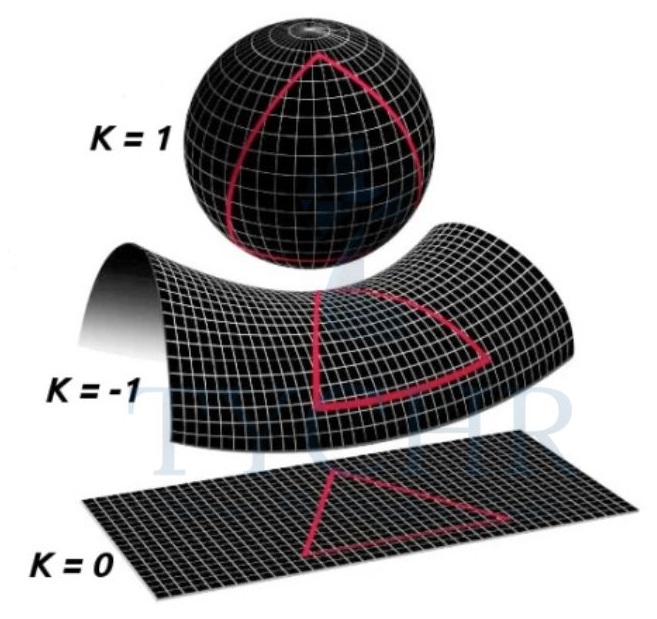
The density required to create a perfectly flat universe is called critical density.
𝜌𝑐 = 3𝑣 2/8𝜋𝐺𝑅2
The expanding universe:
The frequencies of light from distant galaxies were measured and were found to be red shifted. This is called Cosmological red shift. If this was due to doppler effect, then all the stars are moving away from earth.
𝑣/𝑐 = Δ𝜆 /𝜆𝑒𝑚 = 𝑧
v is the recessional velocity,
c is the speed of light,
Δ𝜆 is the change in wavelength,
𝜆 is the wavelength originally emitted from the galaxy and
z is the fractional increase or z parameter.
Hubble’s law:
The recessional velocity of a galaxy is directly proportional to its distance.
𝑣 = 𝐻0𝑑
H0 is the Hubble constant and its value is 72kms-1Mpc-1. It is to be noted that the value of H0 is not constant and the value stated is current value.
The problem with Doppler expansion is that galaxies at sufficient distances recede faster than light. So, Einstein proposed the expansion of space. So, the universe expanding is actually the expansion of space in which they reside.
Scale factor (R):
The scale factor is a measure of how big the universe is relative to today. A scale factor of R means the universe is R times bigger than time. The z parameter and R(tem) (the time of observation of light) when light from distant galaxy is observed are related as:
𝑧 + 1 = 1 / 𝑅𝑡𝑒𝑚
The big bang:
The beginning of the universe was a single point. It was so hot and dense that none of the physics as we know today applies. The age of universe can be estimated to be 1/𝐻0. This gives the age of universe to be 13.6 billion years.
Revisiting critical density:
The critical density can also be written in terms of Hubble’s constant.
𝜌𝑐 =3𝑣2/8𝜋𝐺𝑅2 = 3𝐻02/8𝜋𝐺
The early development of universe:
The development of universe is split into several stages.
- Before 10-43s, we have no model of universe. This is called Planck’s time.
- The universe was a sea of quarks and leptons, both particles and anti-particles existing together.
- Protons and neutrons form. Anti-particles and particles annihilate each other releasing photons which in turn leads to formation of more particles.
- As the wavelength of photons increases due to stretching of space, they no longer form particles. While particles and anti-particles continue to annihilate each other leading to greater number of photons than hadrons.
- Atoms do not form due to the high energy photons that would ionise any atoms formed. Ions in the form of nuclei interact making the universe opaque. The radiation released in this phase has the same spectrum as a black body.
- The universe expands and cools. At some point, the photons no longer have energy to ionise atoms and atoms form. Eventually, the universe as we know today forms.
Cosmic microwave background (CMB):
A microwave antenna pointed in any direction at any place detects uniform radiation whose wavelength is about 1mm. The intensity of this radiation at various wavelengths is found to be exactly the same as that of a black body. This is suspected to be the leftover blackbody radiation from the big bang. From Wein’s displacement law, the temperature corresponding to this radiation is found to be 2.73K. This is very strong evidence for the Big bang theory.
Density parameter:
The density parameter (Ω) is used instead of density. This is the ratio of density to the critical density.
Ω =𝜌/𝜌𝑐
If the density parameter is 1, then the universe is flat. If it is greater than 1, then it is closed and open if less than 1. Calculations with galaxies give the value of to be much less than 1 suggesting an open universe but it is not completely correct.
Rotation curves:
Galaxies are generally rotating. When the velocities of objects are measured, they are lot more than what is predicted. One explanation for this is the presence of dark matter. This matter cannot be observed. So, it is difficult to predict what this matter can be composed of. Two possibilities are WIMPs and MACHOs. WIMPs are weakly interacting massive particles. These are heavy particles like neutrons that do not take part in interactions. MACHOs are massive compact halo objects like black holes or brown dwarfs that may exist on the outer parts of galaxies.
Dark energy:
The rate of expansion of universe is increasing in contrast to the predictions. It is the increase in potential energy that causes kinetic energy to decrease and causes the rate to decrease. If there is some sort of negative energy, then it would cause the opposite effect. This energy is termed dark energy. It has density and can be represented with density parameter (Ω^). If the sum of density components from matter (Ωm) and energy is 1, then the universe is flat.
Anisotropy in CMB:
Cosmic microwave background is not exactly isotropic. It is possible to make a mathematical model of early universe just before becoming transparent. This model predicts the values for Ωm and Ω^. These values are predicted to be 0.27 and 0.73 respectively suggesting that the universe is flat.

